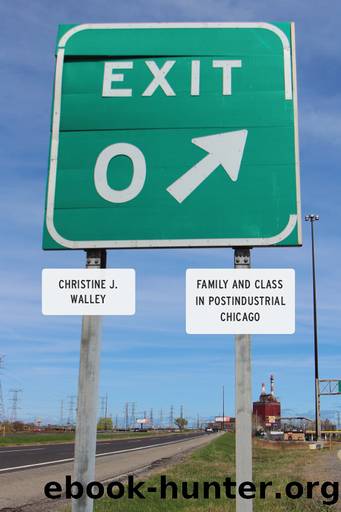Exit Zero by Christine J. Walley

Author:Christine J. Walley
Language: eng
Format: epub
Publisher: The University of Chicago Press
Published: 2013-06-15T00:00:00+00:00
CHAPTER FOUR
The Ties That Bind
Despite having lived for many years in other places, I always return to Southeast Chicago. Members of my family still live there, and these are ties that bind. However, when I go back home now, the area where I grew up is very different. It is strange to think that, in only a few generations, my family witnessed the rise and fall of the steel industry in the Calumet region. From my immigrant great-grandfatherâs first venture into the mills during their rapid expansion in the early twentieth century, to my grandfatherâs struggles in a unionizing era, to the deindustrialization suffered by my parentsâ generation, their lives were inextricably intertwined with that of an industry. This industrial way of life, once considered the bedrock of the US economy, has proven far more ephemeral than any of us could have imagined.
On these return visits home, I am struck, however, by the way the old steel mills continue to assert their presence, despite their physical disappearance. Immediately after the shutdown of Wisconsin Steel in the early 1980s, I would sometimes drive past 106th Street and Torrence Avenue with my dad. As we passed the abandoned buildings of the mill where he had spent so many years of his life, he would mutter bitterly about how heâd like to blow the place up. The empty buildings, overgrown with weeds, seemed to mock him. But it wasnât until 2000, twenty years after the mill shut down, that the last of the buildings that had so offended my father were finally torn down. Even today, the enormous lotâlike those of Republic and US SteelâSouth Worksâremains largely vacant. Although there have been various plans for these spaces over the years, so far these vast brownfields have proved too polluted or too costly to convert to new uses.1 Through such open, gaping wounds on the landscapeâand through their more invisible toxic legacyâthe steel mills still manage to dominate Southeast Chicago.
When I go back to visit Southeast Chicago now and ask my mother for stories about the closing of Wisconsin Steel, she gently chides me: âThat was a long time ago. Things have changed. You canât keep hanging onto the past.â Despite the fact that I left long ago, I realize that for me itâs impossible to move on without a full reckoning with that past. For the country, I believe, it is the same. There is an unacknowledged national need to look back, to reevaluate how and why certain choices were made, and to consider the causes and consequences of deindustrialization and how it has transformed the class landscape of the United States. Without such a reckoning, the social dislocations and resentments set in motion by deindustrialization will continue take their human toll and will haunt the political culture of the United States in destructive ways.
Although I tend to think of my ties to Southeast Chicago as primarily familial or psychological, Iâve been forced to acknowledge, as an adult, another kind of tie that binds, one rooted in biology.
Download
This site does not store any files on its server. We only index and link to content provided by other sites. Please contact the content providers to delete copyright contents if any and email us, we'll remove relevant links or contents immediately.
Life 3.0: Being Human in the Age of Artificial Intelligence by Tegmark Max(5476)
The Sports Rules Book by Human Kinetics(4297)
The Age of Surveillance Capitalism by Shoshana Zuboff(4214)
ACT Math For Dummies by Zegarelli Mark(3996)
Unlabel: Selling You Without Selling Out by Marc Ecko(3591)
Blood, Sweat, and Pixels by Jason Schreier(3566)
Hidden Persuasion: 33 psychological influence techniques in advertising by Marc Andrews & Matthijs van Leeuwen & Rick van Baaren(3474)
The Pixar Touch by David A. Price(3366)
Bad Pharma by Ben Goldacre(3357)
Urban Outlaw by Magnus Walker(3342)
Project Animal Farm: An Accidental Journey into the Secret World of Farming and the Truth About Our Food by Sonia Faruqi(3178)
Kitchen confidential by Anthony Bourdain(3014)
Brotopia by Emily Chang(3001)
Slugfest by Reed Tucker(2943)
The Content Trap by Bharat Anand(2863)
The Airbnb Story by Leigh Gallagher(2800)
Coffee for One by KJ Fallon(2569)
Smuggler's Cove: Exotic Cocktails, Rum, and the Cult of Tiki by Martin Cate & Rebecca Cate(2473)
Beer is proof God loves us by Charles W. Bamforth(2375)
